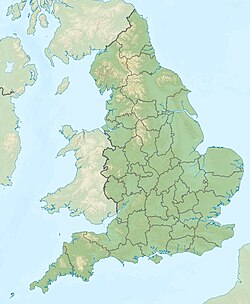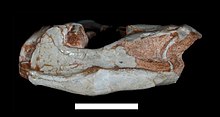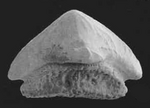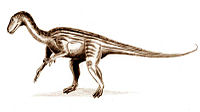The Avon Fissure Fill , also known as the Bristol Fissure Fill or Tytherington Fissure Fill ,[ 1] fissure fill in Avon , England (now Bristol ) which dates variously from the Norian and Rhaetian stages of the Late Triassic , or possibly as late as the Hettangian stage of the Early Jurassic .[ 2] Lower Carboniferous limestones .[ 1]
It is paired with the nearby Magnesian Conglomerate ; it may have been the same formation as the Magnesian Conglomerate.[ 1]
Paleofauna
Taxon
Species
Presence
Notes
Images
Agnosphitys [ 2] [ 3] A. cromhallensis [ 2] [ 3] Geographically present in Avon , England (now Bristol ).[ 2]
Its remains include a left ilium (holotype) and a left maxilla , astragalus and humerus (referred specimen).[ 2]
Agrosaurus [ 4] [ 2] A. macgillivrayi [ 4] [ 2] Geographically present in Avon , England (now Bristol ). Originally believed to have been found in Cape York Peninsula , Queensland (Australia ).[ 2]
A tibia , a claw and some other fragments.[ 2]
Asylosaurus [ 2] [ 5] A. yalensis [ 2] [ 5] Geographically present in Avon , England (now Bristol ).[ 2] [ 6]
Dorsal vertebrae , ribs, gastralia , a shoulder girdle , humeri , a partial forearm, and a hand; additional bones from the neck, tail, pelvis, arm and legs that may represent the same individual.[ 5] [ 2]
Chimaeriformes [ 7] Indeterminate[ 7]
Geographically present in Bristol .[ 2]
Indeterminate remains.[ 7]
Clevosaurus [ 8] C. hudsoni [ 8] Geographically present in Gloucestershire .[ 2]
Partial cranial and post-cranial skeleton (holotype).[ 8]
Crinoidea [ 7] Indeterminate[ 7]
Geographically present in Bristol .[ 2]
Reworked from older Carboniferous sediments (Friars Point Limestone Formation ).[ 9]
Diphydontosaurus [ 7] D. avonensis [ 7] Geographically present in Bristol .[ 2]
Complete to near-complete specimens.[ 7]
Hybodontiformes ?[ 10] Indeterminate[ 10]
Geographically present in Bristol .[ 2]
Indeterminate remains.[ 10]
Gyrolepis [ 11] Indeterminate[ 11]
Geographically present in Bristol .[ 2]
Indeterminate remains.[ 11]
Lissodus [ 10] L. minimus [ 10] Geographically present in Bristol .[ 2]
Teeth.[ 10]
Palaeosaurus [ 2] [ 5] P. cylindrodon [ 2] [ 5] Geographically present in Avon , England (now Bristol ) and Bristol.[ 2]
Two teeth (one destroyed in 1940).[ 2]
Planocephalosaurus [ 12] [ 13] P. robinsonae [ 12] [ 13] Geographically present in Bristol .[ 2]
Skull (holotype).[ 12]
Rhomphaiodon [ 10] R. minor [ 10] Geographically present in Bristol .[ 2]
Teeth.[ 10]
Rileyasuchus [ 2] [ 14] [ 15] R. bristolensis [ 2] [ 14] [ 15] Geographically present in Bristol .[ 2]
Two vertebrae and a humerus.[ 2]
Terrestrisuchus [ 10] [ 7] Indeterminate[ 10] [ 7]
Geographically present in Bristol and South Wales .[ 2]
Indeterminate remains.[ 10] [ 7]
Theropoda [ 2] Indeterminate[ 2]
Geographically present in Avon , England (now Bristol ) and Bristol.[ 2]
Indeterminate remains.[ 2] Pendraig milnerae [ 16]
Thecodontosaurus [ 2] T. antiquus [ 2] Geographically present in Avon , England (now Bristol ) and Bristol.[ 2]
Partial cranial and postcranial remains (holotype is a lower jaw).[ 2]
References
^ a b c Magnesian Conglomerate in the Paleobiology Database ^ a b c d e f g h i j k l m n o p q r s t u v w x y z aa ab ac ad ae af ag ah ai aj ak al am Langer, 2004. Basal Saurischia. In Weishampel, Dodson and Osmolska. The Dinosauria Second EditionUniversity of California Press . 861 pp.
^ a b Nicholas C. Fraser, Kevin Padian, Gordon M. Walkden and A. L. M. Davis, 2002. Basal dinosauriform remains from Britain and the diagnosis of the Dinosauria. Palaeontology . 45(1), 79-95.
^ a b H. G. Seeley. (1891). On Agrosaurus macgillivrayi (Seeley), a saurischian reptile from the N.E. coast of Australia. Quarterly Journal of the Geological Society of London 47:164-165
^ a b c d e Galton, Peter (2007). "Notes on the remains of archosaurian reptiles, mostly basal sauropodomorph dinosaurs, from the 1834 fissure fill (Rhaetian, Upper Triassic) at Clifton in Bristol, southwest England". Revue de Paléobiologie . 26 (2): 505–591.^ Riley H and Stutchbury S (1836a) "A description of various remains of three distinct saurian animals discovered in the autumn of 1834, in the Magnesian Conglomerate on Durdham Down, near Bristol". Geological Society of London, Proceedings , 2 (45): 397-399.
^ a b c d e f g h i j k Mussini, G.; Whiteside, D. I.; Hildebrandt, C.; Benton, M. J. (2020). "Anatomy of a Late Triassic Bristol fissure: Tytherington fissure 2". Proceedings of the Geologists' Association 131 (1): 73– 93. Bibcode :2020PrGA..131...73M . doi :10.1016/j.pgeola.2019.12.001 . ^ a b c W. E. Swinton. (1939). A new Triassic rhynchocephalian from Gloucestershire. ''Annals and Magazine of Natural History: Zoology, Botany, and Geology'' '''4''':591-59
^ Keeble, Emily; Whitestide, David I.; Benton, Michael J. (2018). "The terrestrial fauna of the Late Triassic Pant-y-ffynnon Quarry fissures, South Wales, UK and a new species of Clevosaurus (Lepidosauria: Rhynchocephalia)" (PDF) . Proceedings of the Geologists' Association 129 (2): 99– 119. Bibcode :2018PrGA..129...99K . doi :10.1016/j.pgeola.2017.11.001 . hdl :1983/5afdc677-3ea0-4519-813d-6052ef8370ec . ^ a b c d e f g h i j k l Foffa, D.; Whiteside, D. I.; Viegas, P. A.; Benton, M. J. (2014), "Vertebrates from the Late Triassic Thecodontosaurus -bearing rocks of Durdham Down, Clifton (Bristol, UK)", Proceedings of the Geologists' Association 125 (3): 317– 332, Bibcode :2014PrGA..125..317F , doi :10.1016/j.pgeola.2014.02.002 ^ a b c Romano, Carlo; Koot, Martha B.; Kogan, Ilja; Brayard, Arnaud; Minikh, Alla V.; Brinkmann, Winand; Bucher, Hugo; Kriwet, Jürgen (February 2016). "Permian-Triassic Osteichthyes (bony fishes): diversity dynamics and body size evolution" . Biological Reviews . 91 (1): 106– 147. doi :10.1111/brv.12161 . PMID 25431138 . S2CID 5332637 . ^ a b c Fraser, N.C. (November 1982). "A New Rhynchocephalian from the British Upper Trias" (PDF) . Palaeontology . 25 (4): 709– 725. ^ a b Fraser, N.C.; Walkden, G.M. (August 1984). "The postcranial skeleton of the Upper Triassic sphenodontid Planocephalosaurus robinsonae " (PDF) . Palaeontology . 27 (3): 575– 595. ^ a b von Huene, F. (1902). Überischt über die Reptilien der Trias. Geologische und Paläontologie Abhandlungen, Neu Folge 8:97-156. [German]^ a b Kuhn, O. (1961). Die Familien der rezenten und fossilen Amphibien und Reptilien. Meisenbach:Bamberg , 79 p.^ Spiekman SN, Ezcurra MD, Butler RJ, Fraser NC, Maidment SC (2021). "Pendraig milnerae , a new small-sized coelophysoid theropod from the Late Triassic of Wales" . Royal Society Open Science . 8 (10): Article ID 210915. Bibcode :2021RSOS....810915S . doi :10.1098/rsos.210915 PMC 8493203 PMID 34754500 .









